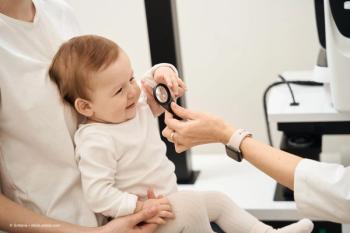
Q&A: Daniela Ferrara on the potential of AI in retina
Daniela Ferrara, MD, PhD, FASRS, Chief Medical Officer at TopCon Healthcare and retina specialist, discussed AI's transformative role in ophthalmology. She moderated a panel at the OIS Retina event exploring how AI can revolutionize clinical trials.
In our convesation, Ferrara identified 2 main AI algorithm types: segmentation algorithms that automate expert tasks like biomarker identification, and future prediction algorithms that forecast retinal conditions. AI is already accelerating clinical trial screening and recruitment while enabling new endpoints requiring automated analysis. She highlighted "ocolomics" research, which uses retinal images to predict systemic diseases like Alzheimer and cardiovascular conditions, representing a shift from theoretical to practical AI implementation in healthcare.
Note: The following conversation has been lightly edited for clarity.
Modern Retina: For those who may be unfamiliar, can you share your background?
Daniela Ferrara, MD, PhD, FASRS: I'm Daniela Ferrara. I'm the Chief Medical Officer for TopCon Healthcare. I'm an ophthalmologist and retina specialist by training, faculty at Tufts University, School of Medicine, and I'm a clinical scientist. My line of research has been in retinal imaging and innovation for the past 25 years. The last decade, I dedicated my clinical research focus to drug development, and now I'm super excited to be in my new role in device in AI-based solutions development.
MR: Can you share a little bit about the panel that you moderated at the recent OIS Retina meeting ahead of ASRS?
Ferrara: I was super grateful to be able to bring together experts from the field of AI and retinal imaging. It was a panel dedicated to the discussion of how artificial intelligence and digital innovation can transform clinical trials, and we had a very productive discussion. I was grateful to have experts from pharma, big and small, experts from the device and algorithm innovation space, and clinicians that can bring the 2 worlds together.
MR: So when we talk about AI and AI in retina. Where do you see the industry headed into the future?
Ferrara: Oh, gosh, I could talk all day about this. So I'll do my best to summarize. So I'm going to comment on the 2 problems we are trying to solve with artificial intelligence, and I'm going to divide my answer in 2 important ecosystems. So thinking about drug development, we want to bring new therapies faster to patients and physicians, and to do that, we need to increase the success rate of drug development. And for that, we need to reduce the timelines, and we want to make sure that drug development is more efficient, and a better use of healthcare resources at large. Artificial intelligence can definitely help with that. When we look into the clinical practice ecosystem, we want to make sure that patients and physicians are making more informed decisions, and we want to truly enable what we have been calling a personalized healthcare or personalized treatment paradigms. Again, artificial intelligence can also help with that.
When I think about the AI technology perspective, what we see, especially in the retina field now are 2 main types of algorithms. We see algorithms that can bring efficiency, reliability, and low cost. Those are what we're calling segmentation algorithms. Basically, they look into a retina imaging, and they automate what human experts can do. So they find biomarkers that we know, and they measure it at the point in time. They measure over time. So it's a better use of resources through automation.
There's another type of algorithms that I'm super excited about, but those are more complex. It's what we're calling future prediction algorithms those algorithms, look at the retinal imaging, and they make assumptions or predictions of the status of that retina in a future state. Sometimes they do that looking to segmentation biomarkers, but sometimes it's what we call a black box, and depending on the modeling approaches, we just don't know what the algorithm is, "seeing." Nonetheless, they're also very powerful technologies.
What excited me the most this year was to see that the problems that we need to solve for in the AI-based solutions that we're building now they are coming together. Very concretely, what that means is we are seeing now in clinical trials for drug development, we are seeing the implementation of AI-based solutions to solve for very specific problems again. So when we think about timelines, as I mentioned before, clinical trials are so lengthy, we can use now when some groups are already using AI-based solutions, for example, to accelerate screening for clinical trials. We can meet patients where they are. In many cases, we can even make a new diagnosis for a patient, and we can help those patients to navigate the clinical trial ecosystem, enabling faster and better recruitment for clinical trials.
Another space that's clearly ahead is the interpretation of clinical trials results. So again, in different papers and different panels, including the one that I had the privilege to chair, we could discuss how now AI-based solutions are at the core of clinical trial result interpretation. And of course, there are many end points that human experts can do and will continue to do, but there's some emerging end points that you need AI to perform image analysis. So it's truly a shift in focus for where the technology is going to. It's from pie in the sky to a very concrete implementation.
Very briefly in the OIS retina panel, but also in other instances, across ASRS, there's a field of research that's also very exciting and with a very significant transformative potential. It's the field of research that has been called ocolomics research. In a nutshell, we use retinal images to make prediction of systemic diseases. Clinicians like me, we've been looking to patients retina and we've been making diagnosis of diabetes, high blood pressure, neurological diseases sometimes. So in a way, we could say that we clinicians have been performing ocolomics, but manual ocolomics. Now in the introduction of AI, truly transformative, preliminary, but very promising results. We are able to use AI now to apply into retinal images and make predictions for neurodegenerative diseases, for example, Alzheimer, MS, Parkinson, and others. We're able to implement AI in retinal images to make much better predictions of cardiovascular and metabolic diseases, for example. So I think let's stay tuned for future research coming from the ocolomics field.
Newsletter
Keep your retina practice on the forefront—subscribe for expert analysis and emerging trends in retinal disease management.















































